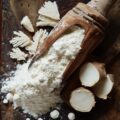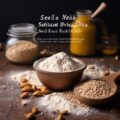The Journey to Perfect Gluten-Free Bread
For those living with celiac disease or gluten sensitivity, the quest for delicious gluten-free bread can feel like searching for the Holy Grail. The aroma of freshly baked bread, the satisfying crunch of a well-toasted slice, and the comforting softness of a warm roll are experiences that everyone deserves to enjoy. Today, we’re embarking on a journey to create the perfect gluten-free bread – one that doesn’t compromise on taste, texture, or nutritional value.
Understanding Gluten-Free Baking
Gluten, a protein found in wheat, barley, and rye, plays a crucial role in traditional bread-making. It provides elasticity and structure, helping bread rise and maintain its shape. When baking gluten-free, we need to find alternatives that can mimic these properties. This often involves a blend of different flours and additives, each bringing something unique to the table.
Some common gluten-free flours include:
- Rice flour
- Almond flour
- Coconut flour
- Buckwheat flour
- Sorghum flour
Each of these flours has its own flavor profile and nutritional benefits, allowing us to create bread that’s not just gluten-free, but also delicious and nourishing.
The Secret Ingredients for Perfect Gluten-Free Bread
Creating the perfect gluten-free bread isn’t just about replacing wheat flour. It’s about understanding how different ingredients interact and finding the right balance. Here are some key ingredients that can elevate your gluten-free bread:
- Xanthan gum or psyllium husk: These ingredients help bind the dough and provide structure, mimicking the role of gluten.
- Apple cider vinegar: A touch of acidity can help activate the leavening agents and improve the bread’s texture.
- Eggs: They add moisture, structure, and richness to the bread. For vegan options, flax eggs can be a great substitute.
- Olive oil or melted butter: These fats add flavor and help keep the bread moist.
Remember, baking is both an art and a science. Don’t be afraid to experiment and adjust recipes to suit your taste preferences and dietary needs.
Baking Techniques for Gluten-Free Success
Baking gluten-free bread requires some different techniques compared to traditional bread-making. Here are some tips to ensure your gluten-free bread turns out perfectly every time:
- Use room temperature ingredients for better mixing and rising.
- Don’t overmix the dough – gluten-free batters are often wetter than traditional doughs.
- Let the dough rest before baking to allow the flours to fully hydrate.
- Use a thermometer to check for doneness – gluten-free bread is fully baked at an internal temperature of 205-210°F (96-99°C).
- Allow the bread to cool completely before slicing to prevent gumminess.
With practice and patience, you’ll soon be baking gluten-free bread that rivals any wheat-based loaf!
Nourishing Your Body and Soul
Baking your own gluten-free bread isn’t just about creating a delicious loaf – it’s an act of self-care and nourishment. When you bake at home, you have control over the ingredients, allowing you to create bread that truly supports your health and wellbeing.
Consider incorporating nutrient-dense ingredients like seeds (chia, flax, pumpkin), nuts, or dried fruits into your bread. These add-ins not only boost the nutritional value but also create interesting flavors and textures.
Moreover, the process of baking itself can be therapeutic. The rhythmic kneading of dough, the warm aroma filling your kitchen, and the satisfaction of creating something with your own hands – all of these can contribute to reduced stress and increased happiness.
Sharing the Love: Gluten-Free Bread for All
Once you’ve mastered the art of gluten-free bread baking, consider sharing your creations with others. Whether it’s a friend who’s newly diagnosed with celiac disease, a neighbor who’s curious about gluten-free eating, or a local food bank in need of gluten-free options, sharing your bread can be a beautiful act of compassion.
Remember, food is more than just sustenance – it’s a way to connect, to show care, and to create shared experiences. By baking and sharing gluten-free bread, you’re not just providing a meal, but also understanding, inclusivity, and love.
Frequently Asked Questions
1. Is gluten-free bread healthier than regular bread?
Gluten-free bread isn’t inherently healthier than regular bread. Its healthiness depends on the ingredients used. Homemade gluten-free bread can be very nutritious if you use whole grain gluten-free flours and add nutritious ingredients like seeds and nuts.
2. Can I use a bread machine to make gluten-free bread?
Yes, many bread machines have a gluten-free setting. If yours doesn’t, you can often use the quick bread setting with good results. Just remember that gluten-free dough only needs one rise, unlike traditional bread.
3. How do I store gluten-free bread to keep it fresh?
Gluten-free bread tends to dry out faster than wheat bread. Store it in an airtight container at room temperature for 2-3 days, or slice and freeze for longer storage. Avoid refrigerating as this can make the bread go stale faster.
4. Why does my gluten-free bread collapse after baking?
This can happen if the bread rises too much during baking and then collapses as it cools. Try reducing the amount of yeast or liquid in your recipe, or lowering the oven temperature slightly.
5. Can I convert my favorite wheat bread recipe to be gluten-free?
While it’s possible to convert wheat recipes to gluten-free, it often requires significant adjustments beyond just swapping the flour. It’s usually easier to start with a recipe specifically developed for gluten-free baking.
Remember, the journey to perfect gluten-free bread is a personal one. What works for one person might not work for another. Be patient with yourself, enjoy the process, and celebrate each loaf as a step towards mastery. Happy baking!









